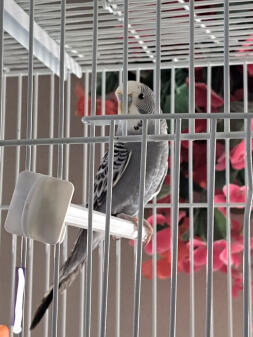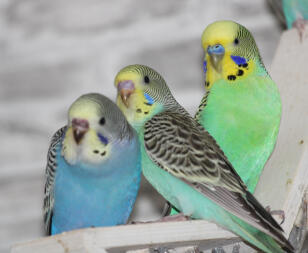A random splodge of colour does not make a variety! To qualify for this tag, the particular plumage pattern, or the colour of the markings, has to be locked in the genes, with the ability to pass to the next generation.
Budgies with markings that differ from those of the standard green/yellow and blue/white types fall into two broad categories – Opaline and Spangle.
Opaline Budgies
This is the commonest variant. Budgies of this variety have less barring on the head, shoulders and back than standard birds, or the barring may be absent altogether. The general body colour is also present in the wing feathers of Opaline birds (i.e. a green/yellow bird usually has black and yellow wing feathers, but in Opalines these are black and green; while a blue/white bird, which normally sports black and white, will have blue and white). Opaline budgies also tend to have bright pastel colours.

Opaline budgies
Spangle Budgies
The pattern of wing markings and throat spots on these birds is distinctive. Most budgies have black wing feathers edged with their underlying body colour (yellow or white); but in budgies with a single Spangle gene these colours are reversed (e.g. yellow feathers edged with black). They have fewer throat spots than standard birds, sometimes none at all. The ones they do have often resemble mini targets, with a white dot at the centre. Budgies with two Spangle genes are predominantly one colour – yellow or white – sometimes with other tones subtly suffusing the plumage.

A Spangle budgie
Yellowface Budgies and Goldenface Budgies
Yellowfaces muddy the waters of the otherwise simple blue/white and yellow/green divide. They are blue type birds with (surprise, surprise) yellow faces, rather than white. In the uncatchily-named Yellowface 1, the yellow is confined to the face, wing edges and tail, with a little more spilling down the blue chest and turning it ever-so slightly green.
Yellowface 2 is more stridently yellow – here, the colour has ‘leaked’ so far down the bird’s body that it turns the bird a striking sea green, with just a few blue bits left untouched. Such a bird will still retain its blue cheek patches.

Yellowface budgie
Goldenface budgies have bright, buttercup yellow faces and a lot of yellow and green in what is still unmistakable a basically ‘blue’ budgie.
Clearbody Budgies
These come in two types, the Texas and the Easley, or Laced. They are basically white or yellow, with the usual black barring pattern on the wings, but with pale grey primary feathers. They also have overtones of colour, depending on their ancestry (i.e. green, blue or grey). The Texas has more colour in the body, and a violet cheek patch; while Easleys look more strikingly two-tone, with silver-grey cheek patches.
English Budgie Types
The concept of the ‘English’ budgie is recognised worldwide. These are the types most commonly bred for budgie shows, and are sometimes referred to as Exhibition or Show budgies. They are a lot bigger than the ancestral wild bird, and look bulkier due to their thicker head feathers, which sometimes fluff up so much that they almost completely conceal the bird’s beak. English budgies may also have extra throat-spots.
English budgies tend to be placid and relatively easy to tame and handle. They also seem to seek out human contact more than their wilder cousins, and hardly ever use their beaks aggressively. This is a result of the selective breeding that has gone into the making of this show bird. Anything wild, flighty and bitey was never going to impress the judges.

English or Show budgies come in many colours
If you’ve only ever owned English budgies, you might not credit this, but they are actually much quieter than the smaller types. Their voices are less shrill, they have fewer squawking fits, and have a laid back, musical air about them, in contrast to smaller budgies’ constant chatting and rapping.
Crested Budgie Types
Excessive feather growth on the head is one of the features of ‘English’ budgies bred for shows. Some varieties have tufts and crests that obscure their faces entirely, occasionally creating a bizarre ‘flower face’ effect. Unlike some animals, however (dogs for example), even the biggest, featheriest and fluffiest budgie in the world does not suffer any physical ill health or discomfort as a result of its outlandish appearance (unless the mutation is the result of a known syndrome, such as the poor ‘Featherduster’ birds, which have stunted wings and a wild maze of overgrown feathers).
Crests are not restricted to English-type birds, though. Like any other gene mutation, it is naturally occurring and has sprung up wherever budgies are kept. Crests are formed by a group of feathers growing in the wrong direction, pointing outwards like a permanent outbreak of bed-head, rather than growing smoothly and close to the body.
There are three basic shapes to budgie head crests – tufted, half-circular and full circular. The tufted crest makes the budgie look like a wannabee cockatiel, while the circular crests are more like ill-advised perms.
The same mutation can also make feathers grow haphazardly elsewhere on the budgie’s body, and in extreme cases the bird can look as if someone has replaced lots of lost feathers using glue and no instruction manual. Such birds are sometimes referred to as frilled.

A frilled budgie
Rare Budgie Types
Very occasionally a new potential variety of budgie emerges from the gene pool. The most recent was the Blackface, a dark bird with a boldly striped head and body, as if they had been zebras in a previous life. These popped up in The Netherlands in the 1990s, but disappeared again when the entire population succumbed to disease (one of the hazards of isolating a new variety in the aviaries of a single breeder). No doubt the mutation will reoccur one day, and the Blackface will rise again - hopefully with a better name this time.
Another rarity that briefly reappears every now and then is the Brownwing, a member of the ‘Brown budgie’ tribe that displays brown markings without reduced body colouring.
These two have yet to settle into new varieties or types, but they are all examples of the diversity and resilience of the budgie gene pool. They may have disappeared for the time being, but they will bubble back to the surface again at some point.
Other rarities include the melancholy-sounding Faded, a type with the grey, washed-out plumage mentioned in the Grey Budgies section, below, but with only a very slight greying effect.
Anthracite budgies have dark grey bodies and cheek patches, along with standard black wing markings and long black tail feathers, as if someone has used a monochrome filter on the usual plumage. The mutation that creates this form is very rare, and the current variety sprang up in Germany in the 1990s. Some experts believe a lost early 20th century variety, the English Grey, was genetically the same as the Anthracite.
The Saddleback variety superficially resembles the Opaline budgie (see above). However, the bird’s head markings are grey, rather than black, and there is a stripe-free ‘saddle’ between its shoulders. The usually black wing marks are also grey, turning darker further down the wing. Saddlebacks also lack the ‘reverse’ wing colour of the Opaline.


















Comments
Christine, 18 July 2021
My budgie is white from head to tail, with very light blue patches on her rump and belly, and light gray patterns across her wings and tail, and I think across her back as well, and her eyes are black. Her cere and feet are light pink/tan. Any ideas?
Teresa, 3 June 2021
Can you feed budgies butter lettuce? I saw no mention of lettuce in your article about feeding fresh veggies. So is butter lettuce a good choice?
Pearl, 27 April 2021
How rare are the yellow/golden faced parakeets?
Anton, 4 May 2019
I saw a "blackfaced" budgie in a lot offered for sale at the bird market. They were tiny budgies about forty in a cage (poor things) one stood out quite dramaticaly. It had those bold zebra stripes all over it, it was overall quite a dark bird and lacked any other colour, kind of monochrome but very attractively different, almost hynotic. I was facinated and wanted to purchase it but as I had to leave the next morning and didn't want to get a new bird to be left with the house keeper decided not to. I thought about it for ages, though. I kept going back, the seller was getting curious and i expect the price was begining to rise, but he was'nt sure what I was looking at exactly. When I got back from my trip the whole cage was gone already, think someone bought the whole flock. They weren't exactly remarkable, cute and healthy looking but nothing special, mostly wild colour. They were tiny though, which I found rather charming, I've never seen such tiny budgiregars. I haven't seen that mutation again. It was quite striking, it did look like a little zebra budgie and just the one. Never forgot it, reading this I now know exactly what I saw , I wasn't dreaming.
Tanya, 6 March 2019
Can somebody help me with telling me what variety my budgies are as ive tried to read up on it and im totally confused. I will upload a pic of them if i am allowed too on here, i have a light green hen and white and pale blue cock.